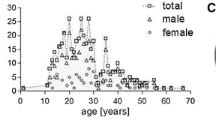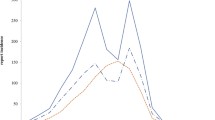Abstract
Purpose
The current extent of migration poses emerging socio–economic and humanitarian challenges. Little is known on vaccination rates in migrants entering Europe, and the implementation of guidelines for serological testing and vaccination of refugees are pending.
Methods
We conducted seroprevalence analyses for measles, mumps, rubella and varicella (MMRV) in 678 refugees coming to Germany during the current crisis.
Results
The mean age of refugees was 28.8±11.4 years, and 76.1 % of subjects were male. Overall, IgG seronegativity was 7.4 % (95 % CI 5.5-9.6) for measles, 10.2 % (95 % CI 8.0-12.5) for mumps, 2.2 % (95 % CI 1.2-3.4) for rubella, and 3.3 % (95 % CI 1.9-4.9) for varicella. Seropositivity rates were age-dependent with considerably low values in children. For example, overall MMR immunity was 90.9 % (95 % CI 88.8-93.1), but only 73.1 % of minor aged refugees displayed complete seroprevalence against all three diseases, and only 68.9 % of children and adolescents were completely MMRV immune.
Conclusion
Our initial data set suggests overall satisfactory MMRV immunity in adult migrants coming to Europe, but the observed low MMRV seroprevalences in refugee children support thorough and prompt vaccination of young migrants entering Europe. Taken together, our data set underlines the urgent need to implement and validate vaccination guidelines for refugee care in the current crisis.



Similar content being viewed by others
Abbreviations
- EU:
-
European Union
- IgG:
-
Immunoglobulin G
- MMRV:
-
Mumps/measles/rubella/varicella
- VPD:
-
Vaccine-preventable diseases
References
Cousins S. Syrian crisis: health experts say more can be done. Lancet. 2015;385:931–4.
Lam E, McCarthy A, Brennan M. Vaccine-preventable diseases in humanitarian emergencies among refugee and internally-displaced populations. Hum vaccines immunother. 2015;11:2627–36.
Jakab Z. Population movement is a challenge for refugees and migrants as well as for the receiving population. 2015. http://www.euro.who.int/en/health-topics/health-determinants/migration-and-health/news/news/2015/09/population-movement-is-a-challenge-for-refugees-and-migrants-as-well-as-for-the-receiving-population. Accessed 18 July 2016.
WHO. Elimination Measles and Rubella - Framework for the elimination process in the WHO European Region. 2014. http://www.euro.who.int/__data/assets/pdf_file/0009/247356/Eliminating-measles-and-rubella-Framework-for-the-verification-process-in-the-WHO-European-Region.pdf. Accessed 15 July 2016.
Poethko-Muller C, Mankertz A. Seroprevalence of measles-, mumps- and rubella-specific IgG antibodies in German children and adolescents and predictors for seronegativity. PLoS One. 2012;7:e42867.
Ständige Impfkommission (STIKO) am Robert Koch-Institut. Empfehlungen/Stand: August 2015. Epidemiol Bull RKI. 2015;34:327–62.
European Commission. Eurostat. 2015. http://ec.europa.eu/eurostat/statistics-explained/index.php/Asylum_statistics#Asylum_applicants. Accessed 18 July 2016.
Robert Koch-Institut. Konzept zur Umsetzung frühzeitiger Impfungen bei Asylsuchenden nach Ankunft in Deutschland. 2015. Epidemiol Bull RKI. 2016;41:439–44.
WHO-UNHCR-UNICEF. Joint technical guidance: general principles of vaccination of refugees, asylum-seekers and migrants in the WHO European region. 2015.
Takla A, Barth A, Siedler A, Stocker P, Wichmann O, Delere Y. Measles outbreak in an asylum-seekers’ shelter in Germany: comparison of the implemented with a hypothetical containment strategy. Epidemiol Infect. 2012;140:1589–98.
Author information
Authors and Affiliations
Corresponding author
Ethics declarations
Conflict of interest
None to specify.
Additional information
A. Jablonka and C. Happle contributed equally to this work.
Electronic supplementary material
Below is the link to the electronic supplementary material.
Rights and permissions
About this article
Cite this article
Jablonka, A., Happle, C., Grote, U. et al. Measles, mumps, rubella, and varicella seroprevalence in refugees in Germany in 2015. Infection 44, 781–787 (2016). https://doi.org/10.1007/s15010-016-0926-7
Received:
Accepted:
Published:
Issue Date:
DOI: https://doi.org/10.1007/s15010-016-0926-7




